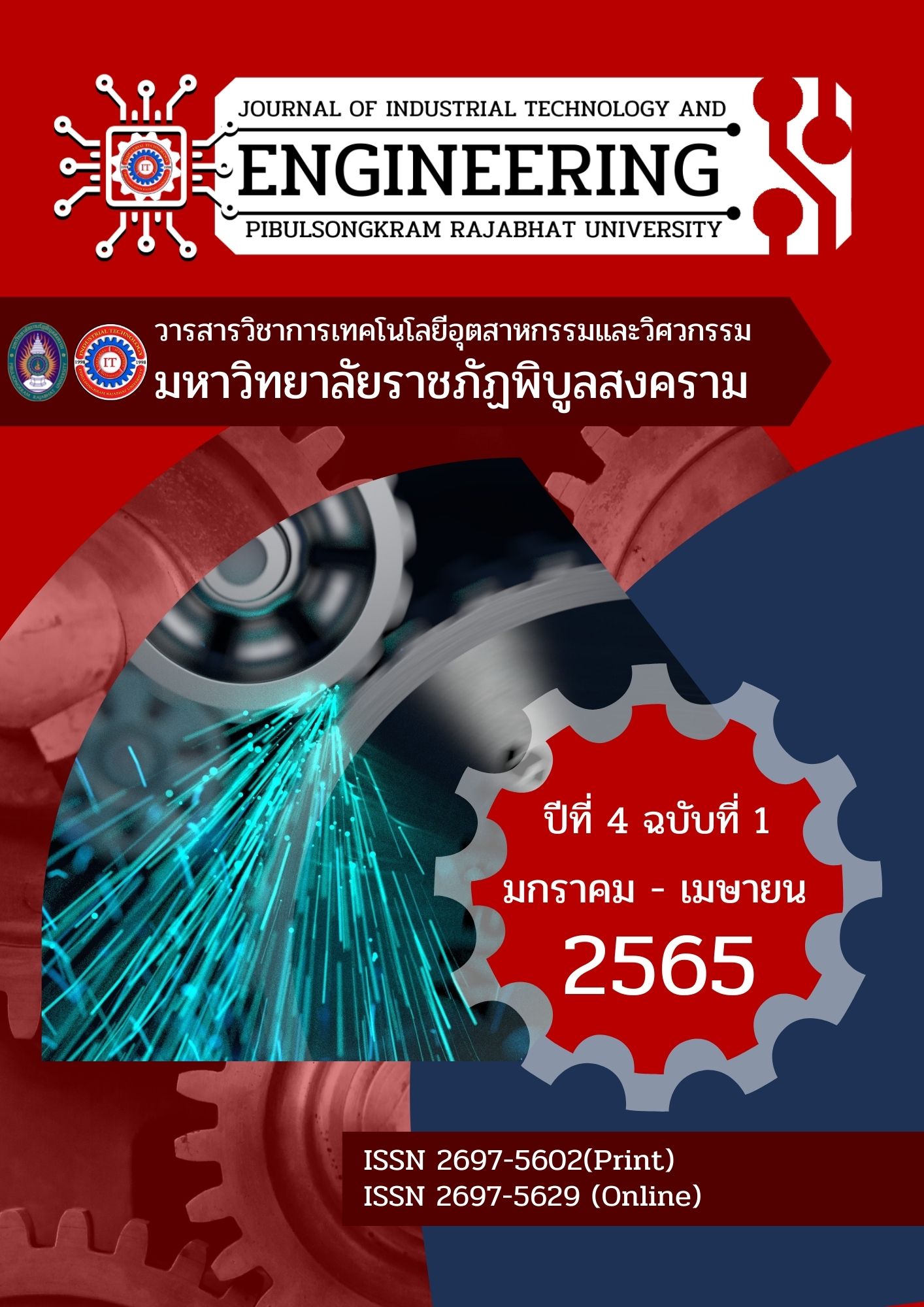การพัฒนาเครื่องอบแห้งที่ใช้ชีวมวลเป็นเชื้อเพลิง
คำสำคัญ:
การอบแห้ง, เชื้อเพลิงชีวมวล, สมรรถนะเครื่องอบแห้งบทคัดย่อ
งานวิจัยนี้มีแนวคิดจากปัญหาประชากรของประเทศไทยที่มีอัตราการเป็นโรคมะเร็งเพิ่มขึ้นมากอย่างต่อเนื่อง โดยเฉพาะมะเร็งตับ มะเร็งกระเพาะอาหาร และมะเร็งลำไส้ใหญ่ ซึ่งมีสาเหตุจากการบริโภคอาหารประเภทปิ้ง ย่าง รมควัน และทอดด้วยน้ำมันซ้ำ ที่ทำให้เกิดสารก่อมะเร็งจำพวกสารเฮทเทอโรชัยคลิกเอมีน และสารโพลีไคลิอะโรมาติกไฮโดรคาร์บอน และปัญหาการทำแห้งด้วยกระบวนการตากแดดจะประสบปัญหาสำคัญที่ไม่อาจหลีกเลี่ยงได้นั้นคือ ช่วงของฤดูฝน และช่วงของการไม่มีแสงแดดจากพระอาทิตย์จะส่งผลต่อคุณภาพที่ไม่ดีของผลิตภัณฑ์อย่างชัดเจน ดังนั้นงานวิจัยนี้จึงมีวัตถุประสงค์เพื่อพัฒนาเครื่องอบแห้งที่ใช้ชีวมวลเป็นเชื้อเพลิงด้วยเทคนิคการนำความร้อนจากเปลวไฟไม่ให้สัมผัสกับอาหารโดยตรงผ่านเครื่องแลกเปลี่ยนความร้อน โดยได้ออกแบบห้องอบแห้งความจุ 10 กิโลกรัม และสร้างเครื่องแลกเปลี่ยนความร้อนจากเปลวไฟ โดยใช้เศษกิ่งไม้ที่หาได้ในพื้นที่เป็นเชื้อเพลิง สำหรับผลิตภัณฑ์ที่ใช้ในการทดสอบสมรรถนะเครื่องอบแห้งที่ใช้ชีวมวลเป็นเชื้อเพลิงคือ เนื้อหมูที่ใช้สำหรับการแปรรูปเป็นเนื้อหมูแดดเดียว โดยมีปัจจัยที่ศึกษาประกอบด้วยอุณหภูมิอบแห้ง 55, 60 และ 65 ֯C และความเร็วลมภายในห้องอบแห้ง 1.0, 3.0 และ 6.0 m/s โดยมีพารามิเตอร์ที่เป็นเกณฑ์ในการศึกษา คือ อัตราการอบแห้ง และความสิ้นเปลืองพลังงานจำเพาะ จากการศึกษาพบว่า การเพิ่มอุณหภูมิอบแห้งหรือความเร็วลมส่งผลทำให้อัตราการอบแห้ง และความสิ้นเปลืองพลังงานจำเพาะเพิ่มขึ้น โดยพบว่าอัตราการอบแห้งและความสิ้นเปลืองพลังงานจำเพาะมีค่าอยู่ระหว่าง 0.12 – 0.29 kg/hr และ 0.05 – 0.08 MJ/kg ตามลำดับ และสุดท้าย เครื่องอบแห้งที่พัฒนาขึ้นในงานวิจัยนี้เคลื่อนย้ายได้สะดวกและสามารถผลิตหมูแดดเดียวได้ในทุกเวลา อย่างไรก็ตามจะต้องดำเนินการในที่ร่มสำหรับช่วงฤดูฝน
เอกสารอ้างอิง
Bosomtwe, A., Danso, J.K., Osekre, E.A., Opit, G.P., Mbata, G., & Armstrong, P. (2019). Effectiveness of the solar biomass hybrid dryer for drying and disinfestation of maize. Journal of Stored Products Research, 83(9), 66-72.
Doi: 10.1016/j.jspr.2019.05.011
Dhanushkodia, S., Vincent, H., Wilsonb, & Sudhakarc, K. (2017). Mathematical modeling of drying behavior of cashew in a solar biomass hybrid dryer. Resource-Efficient Technologies, 3(4), 359-364. Doi: https://doi.org/10.1016/j.reffit.2016.12.002
Elieser, T. (2018). Mathematical modeling and simulation of a solar agricultural dryer with back-up biomass burner and thermal storage. Case Studies in Thermal Engineering, 12, 149-165. Doi: 10.1016/j.csite.2018.04.012
Fabrice, A.N., & Yvette, J.N. (2017). Modeling and simulated design: A novel model and software of a solar-biomass hybrid dryer. Computers & Chemical Engineering, 104, 28–140. Doi: https://doi.org/10.1016/j.compchemeng.2017.04.002
Gowtham, M., Amrit, O.N., Manoj, T., & Ram, K.G. (2012). Design and analysis of biomass drying unit with waste heat. Procedia Engineering, 38, 1161–1165.
Hamdani, Rizal, T.A., & Zulfri, M. (2018). Fabrication and testing of hybrid solar-biomass dryer for drying fish. Case Studies in Thermal Engineering, 12, 489-496.
Doi: https://doi.org/10.1016/j.csite.2018.06.008
Henrik, H., Johan, I., & Risto, L. (2014). Minimization of total drying costs for a continuous packed-bed biomass dryer operating at an integrated chemical pulp and paper mill. Biomass and Energy, 71, 431-442.
Ida, B.A., Gede, B.S., & Made, M.I. (2020). Utilization of rice husk biomass
in the conventional corn dryer based on the heat exchanger
pipes diameter. Case Studies in Thermal Engineering, 22, 100764.
Doi: https://doi.org/10.1016/j.csite.2020.100764
Nawshad, H., & Michael, S. (2013). Techno-economic and environmental
evaluation of biomass dryer. Procedia Engineering, 56, 650-655.
Doi: https://doi.org/10.1016/j.proeng.2013.03.173
Ndukwua, M.C., Diemuodeke, E.O., Abamc, F.I., Abada, U.C., Nnanna, E., & Simo, T.M. (2020). Development and modelling of heat and mass transfer analysis of a low-cost solar dryer integrated with biomass heater. Application for West African Region Scientific African. 10, 1-12. Doi: 10.1016/j.sciaf.2020.e00615
Ndukwu, M.C., Simo, T.M., Abam, F.I., Onwuka, O.S., Prince, S., & Bennamoun, L. (2020). Exergetic sustainability and economic analysis of hybrid solar-biomass dryer integrated with copper tubing as heat exchanger. Heliyon, 6(2), 1-12.
Doi: https://doi.org/10.1016/j.heliyon.2020.e03401
Pathipat, T., Pakamon, P., & Kajorndaj, P. (2017). Utilization of biomass energy in
drying of glutinous rice crackers. Energy Procedia, 138, 331–336.
Doi: 10.1016/j.egypro.2017.10.131
Rabha, D.K. (2021). Performance investigation of a passive-cum-active dryer with a biomass-fired heater integrated with a plate heat exchanger. Renewable Energy, 169, 598-607. Doi: https://doi.org/10.1016/j.renene.2020.12.126
Sonthawi, S., Phaochinnawat, C., Kitti, F., Pairoj, K., Anil, K., & Perapong, T. (2016). Computational fluid dynamic analysis of innovative design of solar biomass hybrid dryer: An experimental validation. Renewable Energy, 92, 185-191.
Doi: https://doi.org/10.1016/j.renene.2016.01.095
Sumeet, A., Dipti, P.M., & Shailesh, K.S. (2020). CFD supported performance analysis of an innovative biomass dryer. Renewable Energy, 159, 860-872.
Doi: https://doi.org/10.1016/j.renene.2020.06.039
Yahya, M., Ahmad, F., & Kamaruzzaman, S. (2017). Energy and exergy analyses of solar-assisted fluidized bed drying integrated with biomass furnace. Renewable Energy, 105, 22-29. Doi: 10.1016/j.renene.2016.12.049



